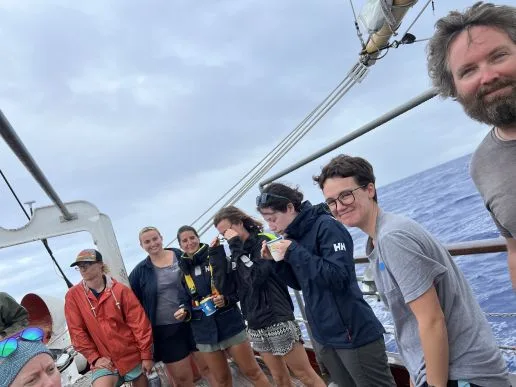Programs Blog
Leaving International Waters

Olivia Wing, A Watch, Whitman College
Ship’s Log
Noon Position
16° 44.5’ N, 153° 50.3’ W
Ship Heading
352°
Ship Speed
4.5 knots
Taffrail Log
2893 nautical miles
Weather / Wind / Sail Plan
Wind ExN, F5. Sailing under the four lowers with a shallow reefed mains’l. Overcast skies, and a chilly 26 °C.
Description of location
Southern Hawaiian EEZ
How time flies. During today’s class time, our Chief Mate set up a place for everyone to predict when we’ll see land in the next few days. It’s hard to believe that we’re so close to Hawaii when the view on deck has been almost constant throughout the voyage. I guess these waves are closer to Hawaii than the waves from yesterday, huh. Sometimes I get a similar feeling during a long elevator ride – I walk into a little room, wait for a moment, and when I walk out I’ve been transported to somewhere completely different. It feels like the end is so close, but that there is so much left to see and do. I guess that feeling, combined with standing dawn watch this morning is making me more reflective today.Speaking of dawn watch, we had our third watch rotation yesterday and we’re finally in Phase 3! Being a Junior Watch Officer for the first time is a little scary, to be honest, but I’ve really started to feel comfortable on deck these last few days, so I’m also excited for the challenge. I remember how good it felt to stage manage a show by myself for the first time. It was a lot of responsibility, yes, but also a sense of freedom and agency, and mutual trust that is so so so hard to replicate outside of that kind of high-stress community situation. I have a feeling that JWO is going to be one of those few times, and that relying on each other so closely is going to enhance my watch’s ability to work together and to trust each other. I saw some of this during the last few days of the second (shadow) phase of this program, when my watch did a whopping 6 gybes during a science station. We only really need 2 for each science station, but everyone wanted to practice calling a maneuver, and so we created the longest, wobbliest, heave-to in the Pacific (in my opinion). Although it seemed like overkill at the time, I feel much better after the practice. Wish me luck tomorrow!Also, who knew it was possible to be cold in the tropics! I’m tempted to start referring to this hemisphere as “the cold north” because I have been wearing a minimum of two layers since we left the ITCZ.To my parents and Elle, and Alistair – thanks for all your birthday messages! It was wonderful to have a little bit of home in the middle of the ocean. I miss you all oh so much. And to everyone I know back home, I can’t wait to hear about what you’ve been up to over the last month or so!Olivia Wing, A Watch, Whitman College
 Fellow A-watchers getting ready for a science-filled morning watch. Left to right: Amelia, Franny, Matt.
Fellow A-watchers getting ready for a science-filled morning watch. Left to right: Amelia, Franny, Matt.
Recent Posts from the Ships
- Ocean Classroom 2024-A collaborative high school program with Proctor Academy
- Collaborations and Long-term Commitments: SEA’s Caribbean Reef Program Sets a Course for Coastal Programs that Compliment Shipboard Experiences.
- Sea Education Association students prepare for life underway using state of the art nautical simulation from Wartsila Corporation.
- SEA Writer 2022, Magazines From the Summer SEA Quest Students
- Technology@SEA: Upgrades Allow Insight into Ocean Depths
Programs
- Gap Year
- Ocean Exploration
- High School
- Science at SEA
- SEA Expedition
- SEAScape
- Pre-College
- Proctor Ocean Classroom
- Protecting the Phoenix Islands
- SPICE
- Stanford@SEA
- Undergraduate
- Climate and Society
- Climate Change and Coastal Resilience
- Coral Reef Conservation
- Marine Biodiversity and Conservation
- MBL
- Ocean Exploration: Plastics
- Ocean Policy: Marine Protected Areas
- Oceans and Climate
- Pacific Reef Expedition
- The Global Ocean: Hawai'i
- The Global Ocean: New Zealand